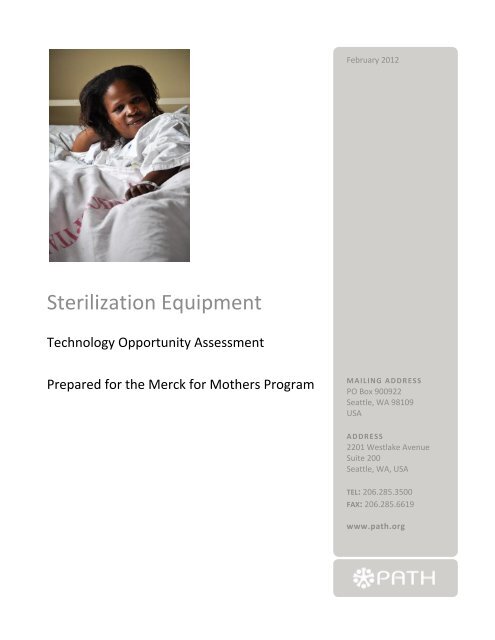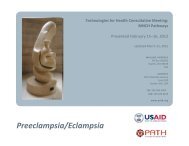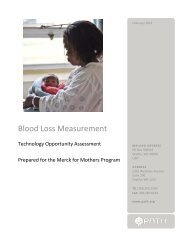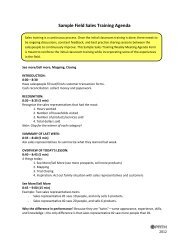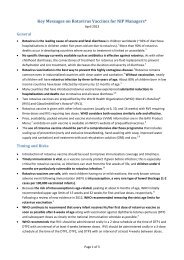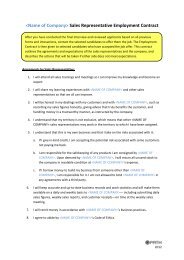486 KB PDF - Program website - Path
486 KB PDF - Program website - Path
486 KB PDF - Program website - Path
- No tags were found...
Create successful ePaper yourself
Turn your PDF publications into a flip-book with our unique Google optimized e-Paper software.
February 2012Sterilization EquipmentTechnology Opportunity AssessmentPrepared for the Merck for Mothers <strong>Program</strong>MAILING ADDRESSPO Box 900922Seattle, WA 98109USAADDRESS2201 Westlake AvenueSuite 200Seattle, WA, USATEL: 206.285.3500FAX: 206.285.6619www.path.org
Copyright © 2013, <strong>Program</strong> for Appropriate Technology in Health (PATH). All rights reserved.Cover photo credit: PATH/Amy MacIver.Funding for this technology assessment was provided by Merck.
Sterilization EquipmentSummaryAll health care facilities should have access to sterilization equipment to reduce disease transmission,including during emergency obstetric procedures. While the World Health Organization (WHO)recommends using autoclaves (technologically advanced sterilizing equipment) at the district hospitallevel, there are various innovations for sterilization that could be useful in low-resource settings.Statement of NeedAround 15% of all pregnant women develop a potentially life-threatening complication that calls forskilled care from a facility that provides emergency obstetric care (EmOC). 1 Skilled care is needed toprovide basic EmOC services defined as parenteral administration of antibiotics, uterotonics, andanticonvulsants; manual removal of the placenta and retained products; assisted vaginal delivery; basicneonatal resuscitation; and the ability to perform these services at community health centers (basicfacilities). 2Additional skills are needed to provide comprehensive EmOC services, defined by the additional signalfunctions of cesarean delivery and blood transfusion to address certain complications such as obstructedlabor, severe hemorrhage, and complications from abortion. WHO recommends four basic EmOCfacilities and at least one comprehensive EmOC facility per every 500,000 population. Facilities withcomprehensive EmOC services must be equipped with anesthetic machines, monitors, respirators andoxygen supply, sterilizing equipment, and other equipment suitable for the level of service. 3 A recentanalysis of 24 national or near-national needs assessments showed that all but two countries met theminimum acceptable level of one comprehensive EmOC facility per 500,000 population, and in countrieswith high maternal mortality ratios the number of basic facilities was insufficient. 4 Lack of basic facilitiesand the need for more comprehensive facilities contributes to the inability to meet the fifth United NationsMillennium Development Goal, to reduce maternal mortality. 5 Constraints are numerous and are oftendue to lack of equipment, inadequate equipment maintenance, poor training, and insufficientinfrastructure. There is a need for EmOC technologies that are reliable, cost-effective, and easy toimplement in both basic and comprehensive facilities.All health care facilities should have access to recommended basic infection-prevention processes toreduce disease transmission from soiled instruments and other reusable items. The steps for processingare decontamination, cleaning, and either sterilization or high-level disinfection (HLD). 5,6 Sterilization isthe safest and most effective method for the final processing of instruments, ensuring that instruments arefree of all microorganisms including bacterial endospores. WHO recommends autoclaving (steamsterilization at 121°C for 30 minutes) for sterilization at the district hospital 7 in preference to other1
sterilization technologies (including dry heat, chemical, gas, plasma, etc.). In peripheral health centers,sterilization equipment may either be unavailable or unsuitable because of price, size, or powerrequirements. In these cases, HLD has been the only acceptable alternative. * Although the HLD processdestroys all microorganisms (including vegetative bacteria, tuberculosis, yeasts, and viruses) except somebacterial endospores, experts now recommend that autoclave technology be made available down toperipheral health centers. 3Unreliable or nonexistent power sources, high prices for electricity and/or fuel for generators, and highprices for autoclaves or other sterilization equipment have made implementing these recommendationsextremely difficult. As a result, even in areas where surgeries are already performed, one-fifth of thepatients suffer from postoperative infection due to, among other causes, the use of improperly sterilizedequipment. 8 In addition, use of dirty instruments may transmit serious incurable diseases including HIVand hepatitis B and C and other health care-associated illnesses. Serious morbidity and possibly mortalityfrom contaminated instruments could be prevented if reliable sterilization equipment were made availableat all points of care. There is consequently a clear need for sterilization equipment that is robust,affordable, reliable, simple to use, and able to tolerate fluctuations in power or operate on alternate powersources.Technology Solutions LandscapeWhere electricity is a problem, high-pressure steam (autoclave) is the oldest and most widely usedeconomical, practical, effective, and reliable method of sterilization in health care facilities. Ideally, theautoclave should be able to withstand harsh environmental conditions, be reliable, cost less than US$500,be simple to use, have a lifespan of at least five years with minimum servicing costs, and have a shortcycle length. † The autoclave must be able to obtain the minimum temperature requirements and hold thetemperature for the minimum time to achieve microorganism kill. Pressure within the vessel needs to beregulated at 15 pounds per square inch (psi) (103 kPa) to shift the boiling point of water from 100°C to121°C, the temperature at which microorganisms are inactivated. Hold times will vary depending onwrapped or unwrapped loads. Minimum process parameters are 9 :Unwrapped items: 121°C / 15 psi / 20 minutes.Wrapped items: 121°C / 15 psi / 30 minutes.Shorter cycle times can be achieved by increasing the temperature (and therefore the pressure) and are thebasis for immediate use steam sterilization (IUSS) (flash sterilization). IUSS is employed only for itemsto be used immediately after sterilization, not for items to be stored for later use. The need, however, isfor wrapped basic surgical kits that can be stored for later use. There are a number of commercially* HLD can be achieved by boiling in water, steaming (moist heat), or soaking instruments in chemical disinfectants.† Considerations that should be taken into account when choosing an autoclave include: (1) complexity of setting up and operating it, (2) averagelifespan, cost of servicing maintenance, cost and need for replaceable parts, (3) energy source (electric or non-electric), (4) size and range ofitems that can be placed in the autoclave, (5) cycle length, and (6) purchase cost.2
available autoclaves in various sizes and configurations; however most are electrically powered. Below isa list of promising technologies for facilities with erratic, limited, or no electric power supply.Nonelectric “Pressure Cookers”These autoclave devices are designed for placement over an external thermal source such as a coal orwood fire or over a more controlled source such as a propane flame or hotplate. The materials ofconstruction are typically aluminum and/or stainless steel. Controls are manual and cycle times aredetermined and controlled by the end-user. Wisconsin Aluminum Foundry (Manitowoc, WI, USA) makesa line of non-electric steam sterilizers under the All-American Brand (models 1915X, 1925X, 1941). Themodels offer different capacities and range in price from US$319 to US$556. 10 Multiple manufacturers inIndia (Life Steriware, Apothecaries Sundries Mfg. Co., Narang Medical) 11,12,13 appear to offer a similarproduct, however prices are not shown. Instructions for using pressure cookers designed for foodpreparation for the purpose of sterilization are also available but tend to focus on immediate use of theinstruments after the sterilizing cycle is complete. Although food preparation pressure cookers arerelatively inexpensive, these devices are only suitable for steam sterilization if the correct settings arechosen. The likelihood of misuse is high and, therefore, these devices are not recommended.Solar-Powered AutoclavesSolar energy can be used to directly heat matter. Solar concentrators are reflecting shields, usually in theshape of a parabola, which take solar energy from a larger area and concentrate it into a smaller area. Theconcentrated radiated energy is converted to thermal energy. Autoclaves are being developed that followthis principle. Most of the projects are academic; however some of the projects have been tried in the fieldand at least one of the projects is in a pilot involving 1,200 units. The following is a list of the academicprojects, a brief description of their technology, and the current stage of their development:Solarclave. 14 The Solarclave concept began in 2008 when a group of students entered a business plancompetition at the University of Dayton. The concept has since been transferred to MassachusettsInstitute of Technology where Anna Young and a team from the D-Lab have developed the conceptinto working field units in Nicaragua. The latest design uses 90 pocket mirrors to concentrate thesolar rays onto a pressure vessel that produces steam at a sufficient temperature to sterilizeinstruments in the vessel. The device can be manufactured in country with locally sourced materials.Capteur Soleil. A 2011 team of Rice University students have modified the classic Jean Boubourdesign to function as an autoclave. The design includes an array of curved mirrors that focus sunlighton a steel tube filled with water. The tube produces steam that in turn heats a custom-designedhotplate. The hotplate is made available to heat a standard non-electric “pressure cooker” (see above)or any other items requiring a thermal source. The device has not been tested in the field although asimilar version used to heat food and water is being used in Haiti. 15Promethus. 16 In 2003, a team from Sydney University developed an autoclave made from a set oflong copper tubes encased in evacuated solar collector tubes. The solar collector tubes have an3
optically sensitive surface that allows visible and UV radiation to pass into but not out of the tubes.The radiation is absorbed as heat. It is unknown what happened to the Promethus team and if theirdesign has been advanced.Solar Brucke. 17 In 2004, a team from Aillingen, Germany, and Solar Alternatives (India) installed aScheffler reflector-based autoclave at Holy Family Hospital in Mandar, India. The 10-m 2 reflectorheats a 230-kg iron block which functions as a once-through steam generator. The solar-poweredsteam generator is connected to a traditional electric boiler providing a hybrid design suitable forsunny and non-sunny days.The one advantage the solar concentrator autoclaves have over pressure cooker autoclaves is the ability toharness the sun as a reliable power source. Of the four solar concentrator autoclaves identified, theSolarclave technology appears to be the most promising. The design uses simple, readily accessiblecomponents that result in a low-cost yet effective device and is being field tested in Nicaragua.Gap AnalysisA survey of rural clinics in Nicaragua identified that only one in eight had an autoclave of some type. 18Why do so few rural clinics have autoclaves when simple non-electric pressure cooker devices have beencommercially available for many years? Understanding the poor adoption and shortage of pressure cookerdevices is critical to estimating the success of solar concentrator autoclaves. If the main deterrent is fuelsupply needs for pressure cookers, then solar concentrators may succeed. If instead, the main deterrent istraining, perceived high cost of pressure cookers, availability of pressure cookers, or some other reasonunrelated to fuel source, then solar concentrator autoclaves may not address the true needs of the ruralclinic.The complexity of setting up and operating an autoclave varies with the type of autoclave and the qualitycontrol specifications. While most autoclaves are fairly simple to operate and maintain, providers willneed some level of training in their use to ensure that items are being sterilized correctly. Facility staffwill also need to be trained to correctly maintain the autoclave to ensure that the machine is being used ina way that can increase its lifespan. Where possible, mechanical, chemical, or biological indicators shouldbe used to provide evidence that the sterilization cycle was successful. Health facilities must, therefore,have up-to-date guidelines and protocols, trained staff, and the requisite equipment and supplies forprocessing medical and surgical instruments, as well as designated areas and procedures for storingsterilized items.From a technology standpoint, the Solarclave team is iterating their design each time they introduce theproduct in the intended use environment. The current design uses 90 pocket mirrors as a concentrator,locally supplied materials for the pressure vessel and reservoir, and a locally made stand. The product isintended for use at a rural clinic although larger-scale designs suitable for use at district-level hospitals4
have been proposed. The units being used in Nicaragua have a five-hour cycle time. Shorter cycle timesare preferred especially since the autoclave is only available for used during usable daylight hours.Additional development is still required to bring the Solarclave or a similar product to market at scale.The Solarclave design appears to be the most likely to succeed and represents the most promisingtechnology solution for non-electric autoclave needs.Investment OpportunityInfection-prevention processes must be implemented and followed at all points of care, from communityclinics up to tertiary-level hospitals. In facilities that have erratic, limited, or no electricity, equipmentused to sterilize instruments and other reusable items should be designed with these variations taken intoconsideration.Community Clinic Opportunities (benchmark technology—HLD)The Solarclave pilot in Nicaragua will generate sufficient data to determine the technology readiness ofthe design. By partnering with a local cooperative to build the devices (Mujeres Solares de Totogalpa),the Solarclave team should be able to recommend if local manufacturing is the preferred supply chainmodel or if central manufacturing and distribution will yield better results (quality, consistency,availability of components, cost, etc.). The pilot should also yield data regarding training requirements,average daily capacity, durability, and workflow challenges. Investment opportunities for a communityclinic system include:Conduct a survey to determine if community clinics are with/without autoclaves, and if pressurecooker autoclaves are appropriate to fill the needs.Organize a pilot study in another region (Africa, India).Collaborate with the Solarclave team to optimize the design.Analyze make vs. buy alternatives.Generate training materials suitable for regional variations.Generate workflow recommendations that include all steps for sterile item processing.Generate a marketing plan.District Hospital-Level Opportunities (benchmark technology—electric-powered autoclave)The Solarclave solar-powered autoclave team has focused on a design that is targeted at the ruralcommunity clinic level. District hospitals generate a greater volume of materials that need sterileprocessing than a single Solarclave unit can process in a single day. Options to increase capacity are touse multiple units or scale the design. A system at the larger scale may have unanticipated challenges thatrequire design iterations. Therefore, it appears that investment opportunities for district-level hospitaldevices include:5
Conduct a survey to determine how a solar concentrator autoclave would be used in conjunctions withor as a substitute for the hospital’s electric autoclave. Understand if pressure cooker autoclaves areappropriate to fill the needs.Identify the optimal size unit to meet typical capacity requirements of the targeted facility.Complete a conceptual design and prototyping of the new design configuration.Optimize the design.Conduct pilot operation in multiple regions.Determine manufacturing plan and identify manufacturers or generate kit-building instructions.Give consideration to other steps in the decontamination, cleaning, and sterilization process includingfacility, workflow, handling, storage, record keeping, and quality control.6
References1. World Health Organization (WHO). Managing Complications in Pregnancy and Childbirth: A Guidefor Midwives and Doctors. Geneva, Switzerland: WHO; 2003.2. WHO. Monitoring Emergency Obstetric Care – A Handbook. Geneva, Switzerland: WHO; 2009.3. Debas H, Gosselin R, McCord C, Thind A. Surgery. In: Jamison D, Breman JG, Measham AR, et al,eds. Disease Control Priorities in Developing Countries, 2nd ed. New York, NY: Oxford UniversityPress and Washington, DC: The World Bank; 2006:1245–1260.4. Bellagio Essential Surgery Group. Conference on Increasing Access to Surgical Services in Resource-Constrained Settings in Sub-Saharan Africa. June 4–8, 2007; Bellagio, Italy.5. Johns Hopkins <strong>Program</strong> for International Education in Gynecology and Obstetrics. InfectionPrevention Guidelines for Healthcare Facilities With Limited Resources. Baltimore, MD: Johns Hopkins<strong>Program</strong> for International Education in Gynecology and Obstetrics; 2003.6. EngenderHealth. Infection Prevention: A Reference Booklet for Health Care Providers, 2nd ed. NewYork, NY: EngenderHealth; 2011.7. WHO. Surgical Care at the District Hospital. Geneva, Switzerland: WHO; 2003.8. WHO. Distributed Surgical Instrument Sterilization Using Solar-Powered Autoclaves in Low-ResourceSettings: The Need for Surgical Care. WHO; 2010. Available at:http://www.who.int/medical_devices/poster_a18.pdf.9. Rutala W, Weber D, and the Healthcare Injection Control Practices Advisory Committee. Guidelinesfor Disinfection and Sterilization in Healthcare Facilities, 2008. Atlanta, GA: Centers for DiseaseControl and Prevention; 2008.10. Non-electric sterilizer page. Sterilizer USA <strong>website</strong>. Available at:http://www.sterilizerusa.com/autoclaves/all-american-sterilizers/non-electric.html. Accessed March 1,2012.11. Life Steriware <strong>website</strong>. Available at: http://www.autoclaveindia.com. Accessed March 1, 2012.12. Apothecaries Sundries Manufacturing Company <strong>website</strong>. Available at: http://www.ascomedical.com.Accessed March 1, 2012.13. Narang Medical Limited <strong>website</strong>. Available at: http://www.narang.com/autoclave-sterilizers/.Accessed March 1, 2012.14. McBride, A. Sterilizing Surgical Tools with Sunshine. Cambridge, Massachusetts: MIT; 2011.Available at: http://iihlab.wordpress.com/2011/11/01/mitscope-solarclave.15. Rice parlays sun’s saving grace into autoclave [press release]. Houston, Texas: Rice University;May 3, 2011. Available at: http://news.rice.edu/2011/05/03/rice-parlays-suns-saving-grace-intoautoclave/.7
16. Jones RH, Brown I, Przybylko J, Fisher S, Tracey J, Russell N. Portable Solar-Powered Autoclave.Presented at: Health Care Without Harm Competition, April 7, 2003; Geneva Switzerland. Available at:http://www.builditsolar.com/Projects/OddProjects/AutoClaveFirstplace_2.pdf.17. Campaigns page. Katharine Hamnett <strong>website</strong>. Available at:http://www.katharinehamnett.com/images/campaigns/csp_report/Medical-Sterilization-in-Rural-Hospitals.pdf. Accessed March 1, 2012.18. Young A. Solarclave: Equipment Sterilization for Rural Clinics. Presented at: 7th European Congresson Tropical Medicine & International Health, October 4, 2011; Barcelona, Spain. Available at:http://www.ectmihbarcelona2011.org/docs/Young(1).pdf.8


